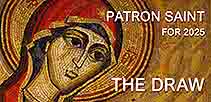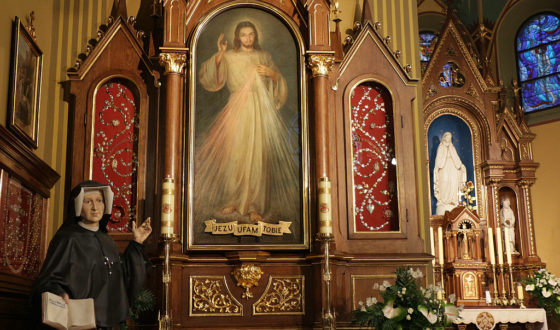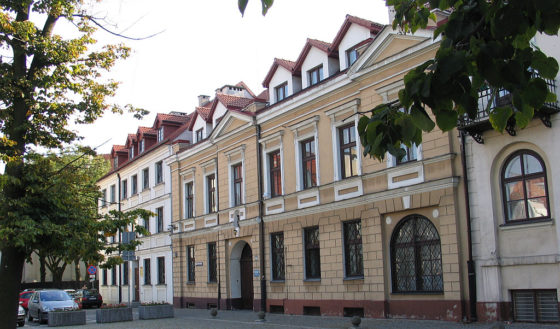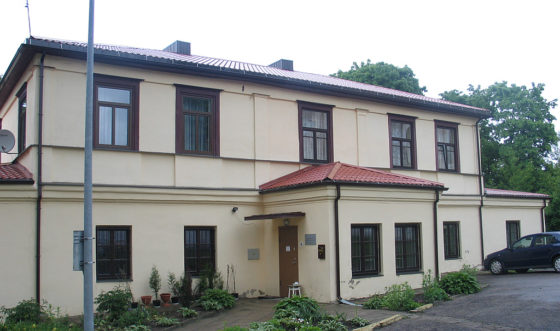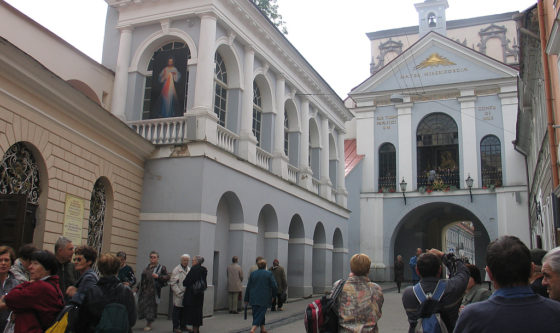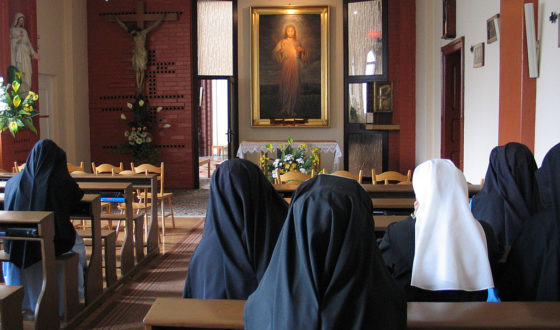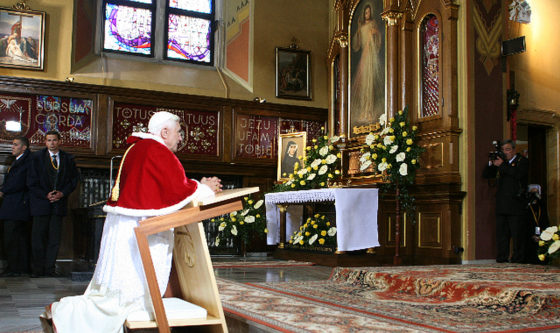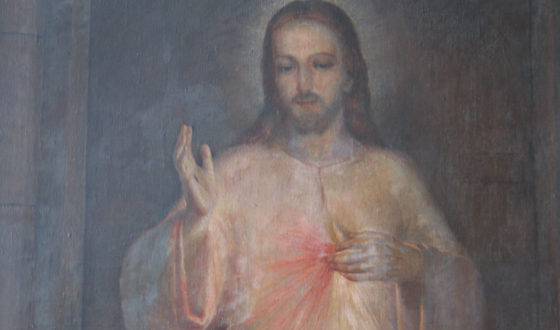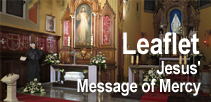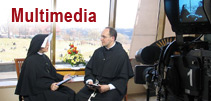The first image of the Divine Mercy, according to the vision which Sister Faustina received, was painted under her supervision in the studio of Eugeniusz Kazimirowski in Vilnius in 1934. During the Second World War other images were painted, and among them the image by Adolf Hyła, painted with the co-operation of Father Józef Andrasz SJ, who was Sister Faustina’s confessor in Kraków. Copies and reproductions of Adolf Hyła’s second image of Merciful Jesus from the convent chapel of the Sisters of Our Lady of Mercy in Kraków-Łagiewniki, quickly spread throughout the world. Thus Jesus’ words about this image were fulfilled: “I desire that this image be venerated, first in your chapel, and [then] throughout the world” (Diary 47).
In the early 1950s, there were more and more complaints from clergy, including bishops, about the introduction of the Divine Mercy image into churches. The image was spreading far and wide; however, as the process of raising Sister Faustina Kowalska to the altars had not yet been initiated, the image was coming from a source not investigated by the Church. Bishops also cited the instructions of the Holy See, which advised great caution when introducing new images. In this situation, in 1954 Father Michał Sopoćko, acting on the suggestion of the Polish Episcopal Conference, organized a competition for the painting of Jesus, presenting Him appearing to the Apostles at the Last Supper after his Resurrection and establishing the sacrament of penance. Three painters took part in the competition, and Ludomir Ślendziński was the winner. On 5 October 1954 the Polish Episcopal Conference accepted this painting for veneration. In spite of numerous attempts by Father Michał Sopoćko, Merciful Jesus’ paintings by Ślendziński did not spread.
In 1959 a Notification appeared prohibiting the spread of devotion to Divine Mercy as given by Sister Faustina. The document left to the shepherds the decision as to whether Merciful Jesus images should be removed from churches. At that time many of these images were removed, but certain churches kept the paintings, and before them the faithful still prayed.
In 1978, following the cancellation of the Notification, images of the Divine Mercy came back into churches. Today there is probably no country without the image of Merciful Jesus painted according to St. Sister Faustina’s vision. Today it is the best known image of Jesus Christ.
The Vision of the image
The prophetic mission of Sister Faustina began with the vision she had in the Płock convent on 22 February 1931, when Jesus ordered her to paint His image. It was the Sunday on which the Church celebrates the Feast of the Cathedral of St. Peter, this being a very significant context for the work that Christ inaugurated in the Church through His ‘Secretary’. Sister Faustina spoke of this event, first to her confessor, who interpreted Jesus’ request on a purely spiritual level, and said: “Paint God’s image in your soul” (Diary 49). But when she was going away from the confessional, the Lord Jesus explained: “My image is already in your soul. (…) I want this image, which you will paint with a brush, to be solemnly blessed on the first Sunday after Easter; that Sunday is to be the Feast of Mercy” (Diary 49). From then on, Sister Faustina knew for certain that the Lord Jesus was asking for a material image, but she had many difficulties in fulfilling this request, because she neither knew how to paint nor was acquainted with anyone who could help her in this. When she came to put this to her superior, Mother Róża Kłobukowska, the superior asked for a sign from heaven, confirming the truthfulness of the revelation. The Lord Jesus said: “I will make this all clear to the Superior by means of the graces which I will grant through this image” (Diary 51).
At the end of 1932 Sister Faustina left Płock and moved to Warsaw, but still the vision of the image of Merciful Jesus had not yet been painted on canvas. The Lord Jesus therefore urged her, saying: “Know that if you neglect the matter of the painting of the image and the whole work of mercy, you will have to answer for a multitude of souls on the day of judgement” (Diary 154).
The Divine Mercy Image painted by Kazimirowski
The first image of Merciful Jesus was not painted until June 1934 in Vilnius. Sister Faustina met Father Michał Sopoćko there, who, as her spiritual guide in Vilnius, was to help her in achieving the mission of Mercy. “Driven by curiosity – remembers Father Sopoćko – as to what the picture would look like, rather than by faith in the authenticity of Sister Faustina’s visions, I decided to have this picture painted. I made an arrangement with an artist, the painter Eugeniusz Kazimirowski, who shared my home, and he undertook, for a sum, to paint the image following the directions of Sister Faustina, whom the Sister Superior allowed to come twice a week accompanied by herself, to indicate what this image was to be.”
The painting of the first image of Merciful Jesus was surrounded by great discretion, which is why Mother Superior Irena Krzyżanowska accompanied Sister Faustina to the artist’s studio. The work lasted for several months, and when the image was finally done (June 1934), Sister Faustina was not pleased with it, and while crying in the chapel complained to the Lord Jesus: “Who will paint You as beautiful as You are?” (Diary 313). In response, she heard: “Not in the beauty of the colour, nor of the brush, lies the greatness of this image, but in My grace” (Diary 313).
The image was placed in a dark corridor at the convent of the Bernardine Sisters, in St. Michael’s Church, where Father Sopoćko was then the rector. Sister Faustina urged her confessor to put the image in the church. “Finally” – Father Sopoćko wrote in his memoirs –“in Holy Week 1935 she announced to me that the Lord Jesus was demanding me to put the image for three days at the Gate of Dawn, where the Triduum would take place, (…) Stanisław Zawadzki, the Gate of Dawn parish priest, asked me to deliver a sermon at the Triduum. I agreed, provided that this image be allowed to adorn the cloister window, where it looked impressive and drew everyone’s attention more than the image of Our Lady.” From 26 to 28 April 1935, at the planned Feast of The Divine Mercy, the new image of the Merciful Jesus, the crucified and risen Saviour of the world, was shown to the world for the first time. This happened at the Gate of Dawn Shrine of Our Lady of Mercy. Sister Faustina herself attended these celebrations, and wrote the following words in the pages of her Diary: “Strangely, all things came about just as the Lord had requested. In fact it was on the first Sunday after Easter [April, 1935] that the image was publicly honoured by crowds of people for the first time. For three days it was exposed and received public veneration. Since it was placed at the very top of a window at the Gate of Dawn, [Shrine of Our Lady, above the ‘Eastern Gate’ to the city of Vilnius], it could be seen from a great distance. At the Gate of Dawn, during these three days, the closing of the Jubilee of the Redemption of the World was being celebrated, marking the nineteen hundred years that had passed since the Passion of our Saviour. I see now that the work of Redemption is bound up with the work of mercy requested by the Lord” (Diary 89).
After these celebrations the image was returned to the Bernardine convent, whence it was brought to adorn altars at Corpus Christi processions. On 4 April 1937, after a favourable opinion by experts, the image of Merciful Jesus was blessed and placed – by permission of the Metropolitan Archbishop of Vilnius, Romuald Jałbrzykowski – in St. Michael’s Church in Vilnius, where it was venerated until 1948.
1937 saw the first reproductions of the copy of the image of Merciful Jesus (by Łucja Bałzukiewiczówna); these were published in Kraków by the Józef Cebulski publishing house. “These pictures” – Sister Faustina wrote in a letter to Father M. Sopoćko – “are not so nice (…). Those who buy them are drawn by the grace of God and God Himself is at work here. Our congregation has bought enough of them. Mother Irena hands out these pictures and booklets. We have even said we will give them away at the convent gate.”
Reproductions and copies of Kazimirowski’s pictures of Merciful Jesus spread during the Second World War. In Vilnius, the photographer Nowicki, commissioned by Father Sopoćko, made thousands of prints of the image in various sizes (the smallest being about one centimetre), which, among other things, were sewn to the hats and shoulder straps of soldiers’ uniforms. Printed pictures of Merciful Jesus were handed out from the convents of the Congregation of Sisters of Our Lady of Mercy, and sent together with parcels to prisons and concentration camps.
In August 1948 the communist authorities closed down the Bernardine Convent in Vilnius, closed St. Michael’s church, and transported its church furnishings, together with the image of Merciful Jesus by Kazimirowski, to still active church of the Holy Spirit, placing them behind the main altar, where the former monastic choir used to be. From there, probably in 1949, Father Józef Grasewicz (a friend of Father Sopoćko and a devotee of the Divine Mercy) took the image of Merciful Jesus from the parish priest Father John Ellert, and placed it in a church in Nowa Ruda (near Grodno), where he was the parish priest. The image with the added inscription: “Jesus, I trust in You” was placed high above the rood screen which separates the chancel from the central nave. Residents of Nowa Ruda prayed before the image for many years, even when the communist authorities closed the church and wanted to convert it into a warehouse. In 1970 all movable property belonging to that church was taken away to the church in Porzecz. Only the image of Merciful Jesus remained, because it was hung too high, and there was not a suitable ladder to remove it. In 1986, the image in the church in Nowa Ruda was secretly replaced, a copy was installed and the original image was transported to Vilnius. In 1987, following necessary conservation work on the canvas, the addition of the signature, and the painting in of the background to the upper part of the image, the picture appeared at the altar of the newly renovated shrine of the Holy Spirit. In 2005 it was moved to the Holy Trinity Church in Vilnius, which was designated the Diocesan Shrine of Divine Mercy.
The Divine Mercy Image painted by Adolf Hyła
The most famous image of Divine Mercy is the one painted by Adolf Hyła, which is in the sanctuary in Kraków-Łagiewniki. The artist painted the image of Merciful Jesus on the basis of Sister Faustina’s description left in her Diary and on the basis of the first image, the Kazimirowski painting, a copy of the reproduction having been given to him by Mother Irena Krzyżanowska, the Superior of the convent of the Congregation of Sisters of Our Lady of Mercy. Father Józef Andrasz SJ (Kraków spiritual guide of Sister Faustina) actively participated in the creation of this image. He had been living in the convent in Łagiewniki since 1942, thus close to the home of the artist.
Father J. Andrasz SJ consecrated the first image of Divine Mercy painted by Mr. Hyła on 7 March 1943. Since this image did not fit into the altar where it was exposed during Masses in honour of Divine Mercy, the Superior of the convent Mother Irena Krzyżanowska commissioned the second image from A. Hyła, intended to correspond in size and shape to the alcove of the side altar. At the same time, Mother Michaela Moraczewska, Superior General of the Congregation of the Sisters of Our Lady of Mercy, commissioned the image for the Kraków chapel from St. Batowski, a Lvov painter. When the image painted by Batowski from Lvov arrived at the convent in Łagiewniki in the autumn of 1943, the sisters were in trouble, because they did not know which image ought to be in the chapel. Cardinal Adam Sapieha helped them, when one day he happened to come to Łagiewniki to rest in the convent garden. Taking advantage of the occasion, the sisters brought the two images to the parlour: those by Hyła and by Batowski. The Cardinal, after hearing the story of the two images, said: “If the image by Hyła is his own votive offering – let it be in the chapel” and for the image by Batowski the Cardinal promised to find a good place (the Church of Divine Mercy in Smoleńsk Street in Kraków).
On the first Sunday after Easter, 16 April 1944, Father J. Andrasz consecrated the new image by Hyła, which corresponded in size and shape to the alcove of the side altar. This image soon became famous for its graces. Copies and reproductions spread around the world, thus fulfilling the words of the Lord Jesus’ to Sister Faustina at the very first revelation: “I desire that this image be venerated, first in your chapel, and throughout the world” (Diary 47). In the original version the landscape of Łagiewniki was painted in the background, but later on – as a result of correspondence with Father M. Sopoćko – the artist painted that over, drawing a floor under the feet of Christ and making the background dark green.
The image was placed on the wall on the right side of the chapel, but for the solemn celebrations in honour of the Divine Mercy, celebrated on the third Sunday of the month, it was moved to the left side altar, formerly occupied by an image of the Sacred Heart of Jesus. In 1959, after the Notification of the Holy See banning the spread of devotion in the forms provided by Sister Faustina, following which images of Merciful Jesus were removed from many churches, the image still remained on the altar in the convent chapel in Łagiewniki, owing to the decision of Archbishop Eugeniusz Baziak.
Some publications have claimed that the image was negatively assessed by the Artistic Committee of the Kraków Curia, and that it is not faithful to the vision which Sister Faustina had in Płock. The faithfulness to the vision can easily be checked by comparing the image with the description in the Diary 47. As for the issue of the views of the church authorities, neither in the Archives of the Curia of Kraków, nor in the Archives of the Sisters of Our Lady of Mercy is there such a document. It seems that the authors of these publications are relying more on the report of the Artistic Board of the Archdiocese of Kraków, which assessed the competition paintings of Merciful Jesus by Antoni Michalak and Tadeusz Okoń. Father Michał Sopoćko was one member of this Commission, and he opposed this interpretation of the image of Merciful Jesus as painted by A. Hyła. Section 2 of the minutes of 29 June 1954 states that “The image by Mr. Okoń is too reminiscent of Mr. Hyła’s images, from which one needs to depart.” It is this sentence referring to the picture of Hyła, which is probably sometimes confused with the assessment of the image of A. Hyła from the shrine in Kraków-Łagiewniki. Father J. Chróściechowski, and other authors following him, cite a sentence from a letter of Father Sopoćko, which includes references to the minutes of the Artistic Committee of the Archdiocese of Kraków, dated 29 June 1954, stating that “one should turn around from this image (by Hyła) because of its feminism – impermissible for devotional images – and its lack of harmonization with the liturgy of Low Sunday, to which the image should be related.” Further search for the separate minutes about the evaluation of the Hyła image (from 29 June 1954) in the Archives of the Curia of Kraków has not confirmed such information. Also Father Prof Adam Bochnak, who participated in the committee, during a conversation with Sister Beata Piekut OLM and Sister Elżbieta Siepak OLM, stated that he did not recall any separate assessment of the image of the Merciful Jesus from the Shrine in Kraków-Łagiewniki. Thus we can conclude that the sentence from the minutes about the evaluation of the images of Michalak and Okoń has been mistakenly treated as pertaining also to an assessment of the image painted by Mr. Hyła.
The Divine Mercy Image from the convent chapel at the Shrine in Kraków-Łagiewniki enjoys great popularity. Copies and reproductions can be found in all corners of the world, not only in churches but also in homes, workplaces and wherever worshippers of the Divine Mercy live and work. People from all over the world come as pilgrims to this image, to beg graces for themselves and others. The numerous votive offerings placed in the boxes on the walls of the chapel evidence the fulfilment of Christ’s promises to those who confidently pray before this image and practice mercy toward others. Karol Wojtyła prayed before this image many times; as priest he celebrated in the presence of this image solemn services in honour of the Divine Mercy; and later as bishop and shepherd of the Archdiocese of Kraków. On 7 June 1997, he prayed by the image as Pope John Paul II. It was then that he said ”Anyone can come here, look at this picture of the Merciful Jesus, his Heart radiating grace, and hear in the depths of his own soul what Blessed Faustina heard: ‘Fear nothing. I am with you always’ (Diary 613). And if this person responds with a sincere heart: ‘Jesus, I trust in you!’ he will find comfort in all his anxieties and fears.” The Holy Father Benedict XVI also prayed before this image on 27 May 2006; church dignitaries pray here, heads of state, scholars, artists, people of different callings and professions, and even different religions. Here, before the Merciful Jesus – as they say – there are no divisions. Here all that matters is a trusting heart and the attitude of practicing mercy toward others.
The Merciful Jesus Image by Ludomir Ślendziński
After the war, in the 1950s, some of those who attended at the Episcopal Conference declared they had reservations about spreading the image of Merciful Jesus, which after all came through private revelations and had not yet been examined by the Church. The Episcopate therefore ordered prudence in dealing with the image of Merciful Jesus according to the vision of Sister Faustina. However, with the purpose of there being a picture of Divine Mercy, and Divine Mercy has been venerated in the Church since the beginning, Father Sopoćko – at the suggestion of the Episcopal Conference – in 1954 organized a competition; artists were invited to paint an image of Jesus appearing to the Apostles at the Last Supper after His Resurrection and establishing the sacrament of penance. Father Sopoćko also invited the painter Adolf Hyła to this competition, the author of many images of Merciful Jesus, including the already famous miraculous image of the chapel of the Sisters of Our Lady of Mercy in Kraków-Łagiewniki. Adolf Hyła however, refused to participate in this contest, because he believed that this was going to be a compromise, which would not serve the devotion of Divine Mercy. Adolf Hyła wrote in a letter to Father M. Sopoćko that “This compromise, among others, shall be to compose an image of Christ the Merciful in such a way as to simultaneously present a scene from His life as described in the Gospels and a number of details of the vision of Sister Faustina. The result, however, of this compromise is a picture that does not present the scene of the Gospel and which narrows the concept of God’s mercy. Indeed, according to the Gospel (Jn 20: 19-24) the Lord Jesus, after entering through the closed doors to the Cenacle, welcomed the disciples saying: “Peace be with you”, he showed them the wounds on His hands and His side, he breathed the Holy Spirit on them and spoke the words with which He instituted the sacrament of penance. The existing image presents just the floor and the upper room door, but Christ Himself is doing something else: He is showing the rays of Blood and Water gushing from His side and He is blessing. At the same time, the proposed image would limit the concept of God’s mercy expressed in the vision of Sister Faustina, because it would only narrow it to the mercy manifested in the sacrament of penance.”
The painting by Ludomir Ślendziński won the competition, which was entered by three artists. The Main Committee of the Polish Episcopate allowed this image for devotion on 5 October 1954, although it gave rise to some objections on artistic grounds. This image (the first image by Ślendziński) is in the chapel of the Sisters of Our Lady of Mercy in Warsaw Grochów (44 Hetmańska Street).
Sr. M. Elżbieta Siepak ISMM
Translated by Orest Pawlak
____________________
See also: Mercy » Devotion to the Divine Mercy » Image










